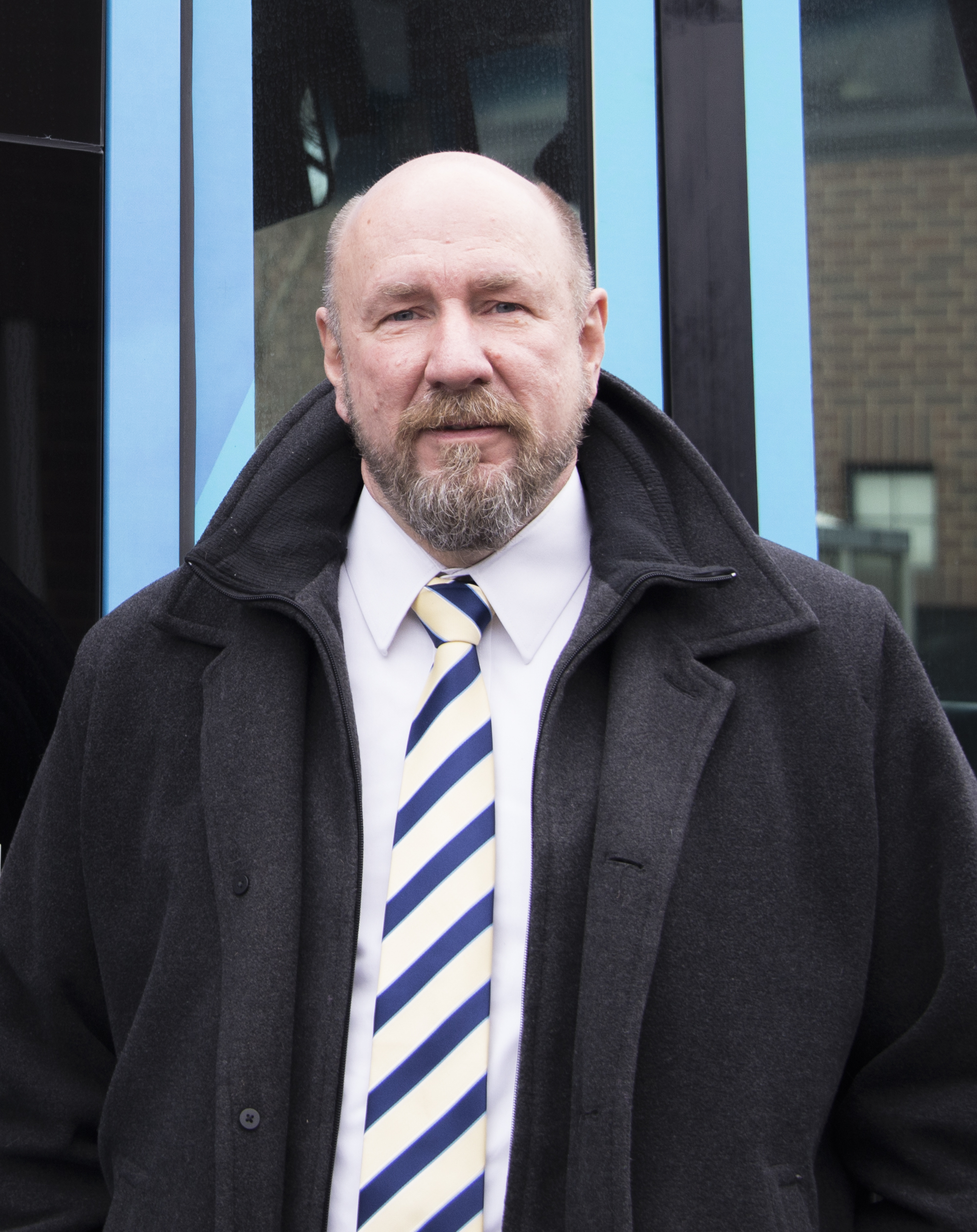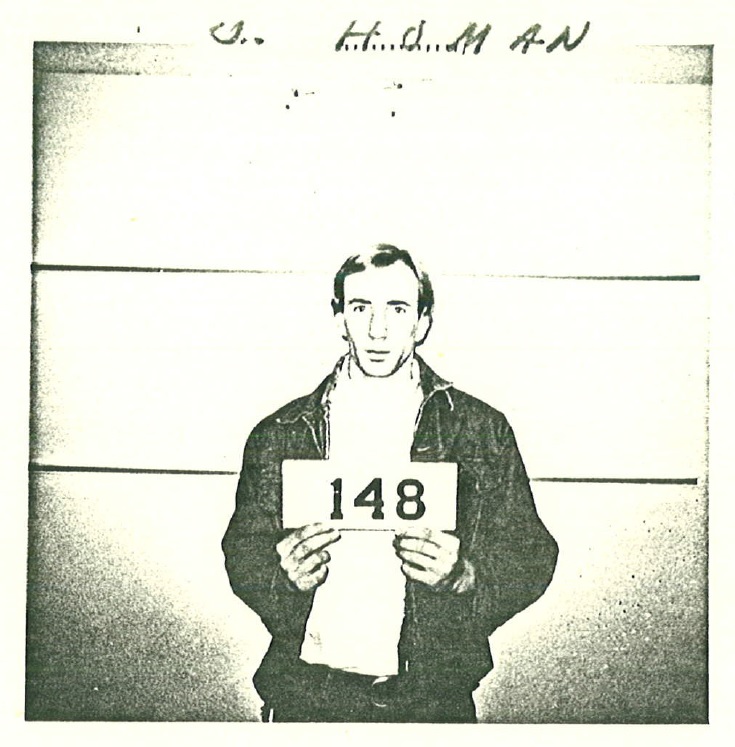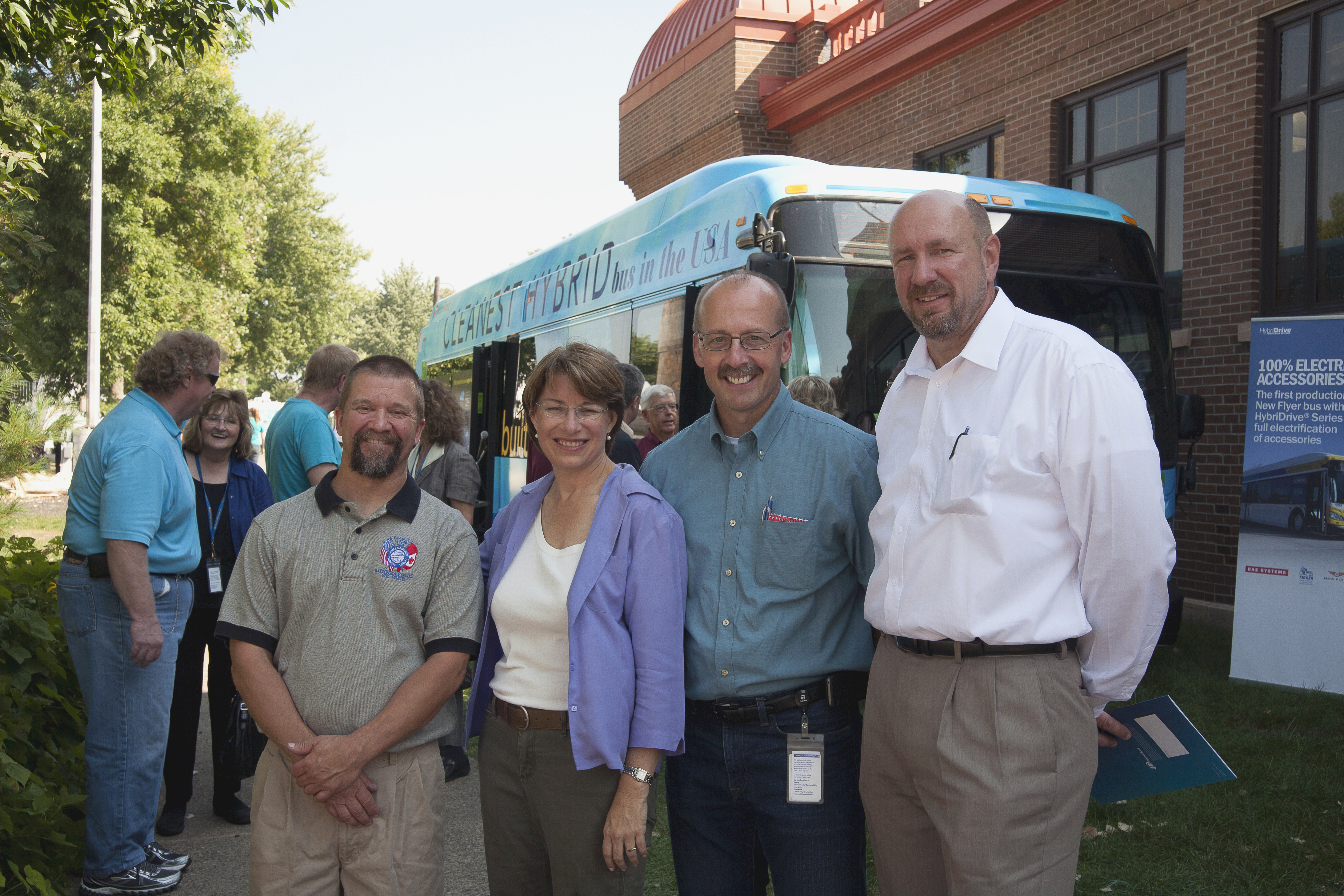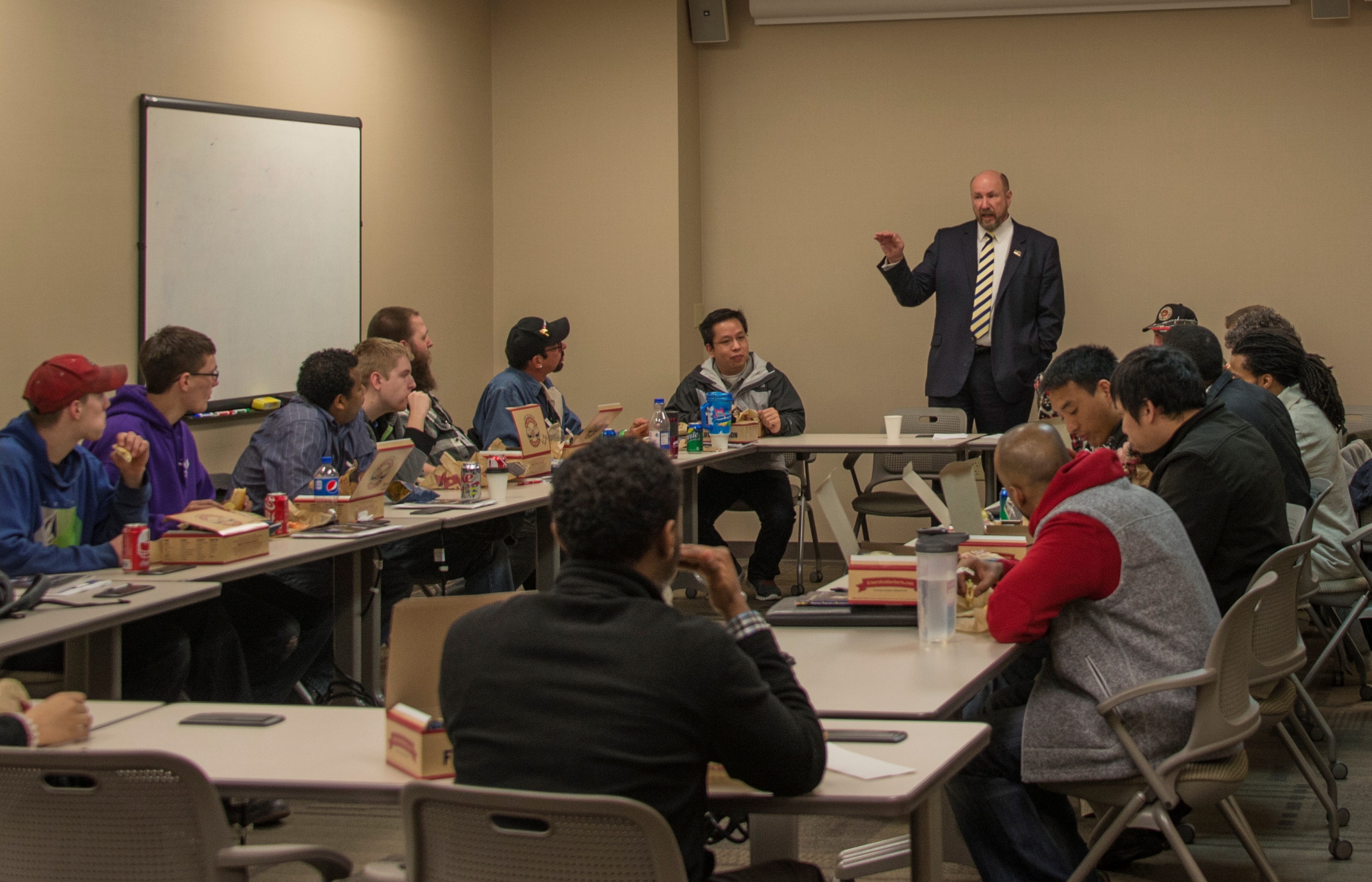 The first night Jan Homan reported for work – Christmas Eve 1975 – he was asked to do nothing more than keep an eye on the new Shingle Creek bus garage.
The first night Jan Homan reported for work – Christmas Eve 1975 – he was asked to do nothing more than keep an eye on the new Shingle Creek bus garage.
A warehouse that would eventually be home to buses, mechanics and operators was for the moment an empty building on a dead-end street.
Left alone on second-shift, Homan took his responsibilities seriously, locking every door in the building and preventing his replacement from entering the building.
“There really wasn’t much to do but he wanted to do it right,” said Bill Porter, who gave Homan that initial assignment and spent several years as his supervisor and colleague. “And that’s been Jan his whole life.”
That first evening might have been the only quiet moment of Homan's 40-year career.
In the decades since the lanky 20-year-old pulled into the Shingle Creek lot driving a 1966 Oldsmobile Toronado, Homan continued to take on new challenges and built a reputation for being an engaged, thoughtful leader who was eager to break new ground both individually and as an organization.
Upon retirement, Homan is also being remembered as a caring leader who set high standards, but also supported people in pursuit of those lofty goals. The result: a dramatic transformation of Metro Transit's bus fleet, and a legacy that will last a lifetime.
###
Long before he was tapped to lead Metro Transit’s bus maintenance and transportation divisions, Homan’s career began the same way it did for many in Bus Maintenance – as a Cleaner sweeping buses for $4.28 an hour.
As a trained mechanic who replaced his first engine at just 15-years-old, it wasn’t the kind of work he was looking for. But what co-workers at the Sears Ridgedale auto shop saw as a step backwards, Homan saw as an opportunity. And in less than a year he was back to being a full-fledged mechanic, working out of the old Northside Garage in Minneapolis.
Homan’s aspirations didn’t end there, either.
In 1979, Homan put his name in to lead maintenance efforts on Metro Transit’s fledgling non-revenue fleet. The job was given to someone else, but his initiative was rewarded with an opportunity to become a foreman at Nicollet Garage. The decision to say yes, he said, “changed his life.”
Homan’s younger brother, Matt, remembers Homan being a manager from a young age – even doling out tasks as they worked together on vehicles at home. But his first experience as a supervisor still had a defined learning curve.
New in his role, Homan asked a group of fuelers to stop playing pool. The team returned to work but buses were soon mysteriously backed up for a full city block. The lesson, Homan said, was to “find out what’s worth taking on and what’s not worth taking on.”
And while he might have learned to be selective, he still found plenty to take on. “Ever since then, I was totally engaged and my days just flew by,” he said.
###
 Homan’s arrival at Metro Transit coincided with another fateful point in the organization’s history: the purchase of more than 300 AM General buses. Built by a former defense contractor entering the transit industry for the first time, the buses quickly proved problematic.
Homan’s arrival at Metro Transit coincided with another fateful point in the organization’s history: the purchase of more than 300 AM General buses. Built by a former defense contractor entering the transit industry for the first time, the buses quickly proved problematic.
“Basically, the whole fleet was going down,” Homan remembers. “And as our buses were breaking down left and right, Bus Maintenance really became the stepchild of the agency.”
Homan wanted to be a part of the solution. So he continued looking for other new leadership opportunities where he could effect change.
The ambition led him to a role overseeing a group of high-seniority mechanics at Overhaul Base, and later to a job as the Maintenance Manager at Heywood Garage – the largest and most challenging of Metro Transit’s five garages.
Homan remembers being intimidated by his growing responsibilities, but embracing them as opportunities to see how much he was capable of. “You do something for a while, make your contributions, and then it’s nice to do something new – to stretch yourself and contribute in another area,” he said.
And contribute he did.
At Heywood, Homan introduced new concepts that allowed mechanics to specialize in specific areas and to work more stable schedules. He also helped re-define the inspection process, moving from crisis repairs toward an emphasis on preventative maintenance.
Just as Homan was getting comfortable, there was a twist: needing to fill a leadership role in Service Development, Homan was tapped to temporarily lead Metro Transit’s Scheduling Department.
He spent the next nine months absorbing information on a subject he admittedly knew little about. And as he had done before, he thrived. “I knew what I could contribute, but I also knew the strengths of others and how to leverage that,” Homan said.
Challenging others to push themselves in the same ways he had would become the hallmark of Homan’s late-career.
###
Twenty-five years after Homan began his career in transit, he found himself leading the department where he got his start. And it was in this role, as Director of Bus Maintenance, that he began thinking about how he could help nurture the careers of others with similar ambitions.
To do so, he championed programs that gave front-line workers without supervisor pedigrees the opportunity to gain the kind of experience they needed to move up in the company. He also challenged mechanics to learn new skills and earn certifications and formed a partnership with his alma mater, North Hennepin Technical College.
Among those who benefited from these efforts was Bill Beck, who participated in what was known as the STEP Program. Beck is now a manager at the Overhaul Base.
“It changed my whole career path and gave me the chances that I have today,” Beck said. “I can’t say enough how much appreciate Jan’s thinking and allowing me to be a part of it.”
Regardless of where someone was at in their career, though, Jan had a knack for encouraging them to aim higher.
“He was really a master at stretching people,” said Joe Reichstadt, Assistant Director of Bus Maintenance. “There wasn’t any team member that wasn’t challenged to think outside the box or normal process and we were thankful for that.”
###
 Homan’s ability to identify and encourage leaders is a defining part of his legacy. But Metro Transit’s fleet also serves as a testament to his career.
Homan’s ability to identify and encourage leaders is a defining part of his legacy. But Metro Transit’s fleet also serves as a testament to his career.
With more than 1,000 buses, Metro Transit’s fleet is among the largest in the nation. It’s also among the most reliable.
In 2015, buses traveled an average of more than 7,500 miles between service road calls – a key measure of fleet reliability. The number has more than doubled over the last decade.
And it might be even higher if Homan hadn’t insisted that all road calls be counted, whether or not Bus Maintenance could identify an issue, to better reflect the customer experience.
Thomas Humphrey, Assistant Director of Bus Maintenance, worked closely with Jan to monitor bus performance and use the data to drive decision-making. “It was all about that core value of holding ourselves to a higher standard,” he said.
Homan also led efforts to embrace new technology. In 2002, Metro Transit became one of the first agencies in the country to incorporate hybrid-electric buses. The agency is also home to two Minnesota-made clean diesel buses that get better fuel economy through the use of all electrically-operated components and propulsion.
Hybrid buses now make up 15 percent of Metro Transit’s fleet, and the agency is exploring the potential for fully-electric buses.
The fleet is also known as being one of the cleanest in the country and for standing up to harsh Minnesota winters.
“We have one of the outstanding fleets in the country – 1,000 buses in the toughest conditions – but we still set the standard for appearance and reliability,” said Vince Pellegrin, who preceded Homan as Director of Bus Maintenance. “When I think of Jan Homan, I really think of the icon of the bus maintenance industry.”
###
 In his final chapter, as Deputy Chief of Operations-Bus, Homan oversaw both the maintenance and transportation divisions. The move gave him an opportunity to shape not just bus maintenance but all aspects of bus operations, including operator training, garage management and street supervision.
In his final chapter, as Deputy Chief of Operations-Bus, Homan oversaw both the maintenance and transportation divisions. The move gave him an opportunity to shape not just bus maintenance but all aspects of bus operations, including operator training, garage management and street supervision.
While it was unknown territory, Homan immediately immersed himself in the transportation side of the business. “He took the time with us to really understand what we do and how important our operators are to the success of Metro Transit,” said Christy Bailly, Director of Bus Transportation.
In this role, Homan helped re-organize the department so leaders could focus exclusively on training, street operations and garage operations. He also helped implement a new employee performance management system that helps managers efficiently monitor operations and stay on track toward short- and long-term goals.
And he continued to be a career-builder, working to re-launch a program that gives staff the managerial experience to advance and initiating a first-of-its-kind effort to create a path to full-time employment by combining skills training, formal education and internships.
The Metro Transit Technician Program launched in late-2015 as a partnership between Bus Maintenance, the Office of Equal Opportunity and the Amalgamated Transit Union 1005. Currently, 24 young people are completing internships and earning associate degrees that will put them in a position to apply for full-time jobs at Metro Transit.
Shortly before retiring, Homan spoke with the group about his own career, telling them that “from now on, you’re going to be learning until the day you retire.”
For Homan, that day has finally arrived. And while he certainly learned a lot along the way, Homan will likely be remembered more for playing the role of teacher.
Ask Homan about the achievements he’s had over his four-decade tenure, though, and you’ll get a characteristically humble response.
“In all my years, it’s never really been about titles but about being able to contribute in a different way,” he said. “And for most part that meant putting great people in place to execute ideas – coming up with a concept and letting them make it a better reality.”
Jan Homan retires from Metro Transit on April 1, 2016. In retirement, he plans to spend time with his family, including wife Mary, son Sam, and two daughters, and to continue improving his property in northern Minnesota. Brian Funk, who most recently served as Director of Light Rail Operations, will serve as the next Deputy Chief of Operations-Bus.
Reflections on Jan Homan’s career
“Jan has grown to be really one of the founding, institutional people in this organization over the last 40 years…Clearly the fingerprints of the improved operations and really the design of the 21st century bus has a lot to do with Jan Homan’s direct involvement and engagement. Beyond that it’s really the way Jan’s engaged people to be the best they possibly can. In the old school, it was more punitive, that you have to do this. Jan’s approach is much more human, which is 'We can do this together.' And I think that’s something that will live beyond Jan’s reign here at Metro Transit and is hallmark of how we want to do business here in the future.” – Brian Lamb, General Manager
“Jan has always let you know what his expectations are, but he also brings you along. He’s been a very good coach over the years…has always liked to bring people along He looks for the good in people, and really brings out the best in them. – Rob Milleson, Director-Bus Maintenance
“He has got the biggest hands I’ve ever seen – strong, rugged hands. I think people follow him because of that. He takes their hand and they are just going.” – Wanda Kirkpatrick, Director-Office of Equal Opportunity
“I consider him to be a quiet leader. If you think of Gandhi, that saying some leaders lead from in front and some lead from behind…He has taken on that responsibility and that role of leadership quite well. And he doesn’t wield it or anything. He’s just very gentle with it, but he gets his point across.” – Marilyn Porter, Director-Engineering & Facilities
“The first time he came into my office to get acquainted – and he’s a very tall gentleman – he sat down at table and he tried to make himself more my height. He stuck his legs out a little, moved to the side. And I think he did that for a purpose – to be more even with me, to speak with me at my level. I think it’s very telling. He’s very respectful and wants everyone he encounters – whether it’s a cleaner, a mechanic, a bus operator a manager, a supervisor a director – to be comfortable around him.” – Christy Bailly, Director-Bus Transportation
Jan Homan’s Career At a Glance
- > December 1975 – Cleaner-Shingle Creek Garage (now the Martin J. Ruter Garage)
- > November 1976 – Mechanic-old Northside Garage
- > March 1978 – Senior Mechanic-old Snelling Garage
- > November 1979 – Foreman-Nicollet Garage
- > June 1985 – Foreman-Overhaul Base
- > June 1992 – Maintenance Manager-Heywood Garage
- > October 1998 – Manager of Maintenance Administration
- > December 2000 – Director-Bus Maintenance
- > March 2013 – Deputy Chief of Operations-Bus